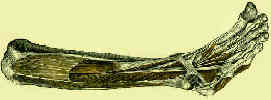- Discussion:
- allows acces to ankle joint, talus, & other tarsal bones and joints;
- it does not allow access to the navicular and 2nd and 1st cuniforms;
- avoids all of the important vessels and nerves;
- dissection procedes between the peroneus tertius (deep peroneal nerve) and the peroneus brevis (superficial peroneal nerve);
- Incision:
- begin the incision over anterolateral aspect of the leg, medial to fibula and 5 cm proximal to the ankle joint;
- continue incision distally to cross over talus, calcaneocuboid joint;
- end incision at the base of 4th metatarsal;
- dissection usually divides anterolateral malleolar & lateral tarsal arteries;
- identify & protect intermediate dorsal cutaneous branch of the superficial peroneal nerve;
- divide origin of EDB and reflect it distally;
- retract the extensor tendons, the dorsalis pedis artery, and the deep peroneal nerve medially, and incise the capsule


